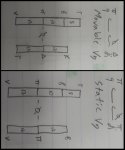GArgiriadis
Νέο μέλος
Kind of a silly question...
In western music solfege, you can have a movable Do or static Do. This means that if you are playing or singing a concert "A" (440 Hz) in the key of A major you can sing "Do" because it is the root note of the scale or you can sing "La" with the understanding that the interval between "Si" and "Do" will be a whole step instead of the usual half step.
The same thing exists in Byzantine chant. The book I'm studying from shows a "Static Ni" system and a lot of the instruction I find online uses a "Movable Ni".
I wonder if anyone knows if either system is more traditional than the other.
Thanks
In western music solfege, you can have a movable Do or static Do. This means that if you are playing or singing a concert "A" (440 Hz) in the key of A major you can sing "Do" because it is the root note of the scale or you can sing "La" with the understanding that the interval between "Si" and "Do" will be a whole step instead of the usual half step.
The same thing exists in Byzantine chant. The book I'm studying from shows a "Static Ni" system and a lot of the instruction I find online uses a "Movable Ni".
I wonder if anyone knows if either system is more traditional than the other.
Thanks



